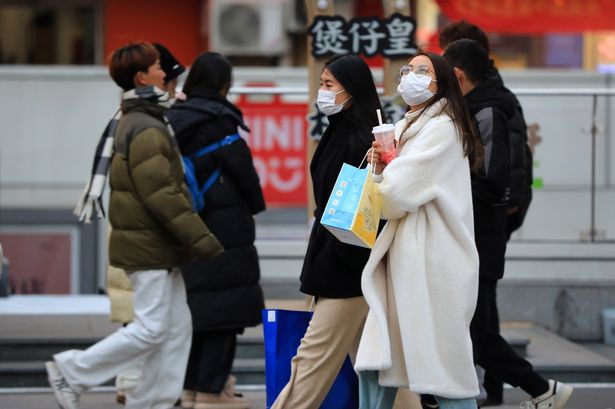Human metapneumovirus (HMPV), a common respiratory virus, has witnessed a recent surge in cases in China, raising concerns about its potential impact on global health. Images emerging from China depict overcrowded hospital waiting rooms, indicative of a significant increase in respiratory illnesses, with HMPV identified as a major contributor. While HMPV is not a novel virus, its recent resurgence, coupled with the backdrop of the ongoing COVID-19 pandemic and the seasonal flu, adds another layer of complexity to the global health landscape. Preliminary data also suggests a rise in HMPV cases in the UK, signaling a potential wider spread in other regions. This situation underscores the importance of continued vigilance and preparedness in confronting respiratory viruses.
HMPV, first identified in 2001, is a paramyxovirus, belonging to the same family as the viruses causing measles, mumps, and respiratory syncytial virus (RSV). It typically causes mild to moderate respiratory illnesses, presenting with symptoms similar to the common cold, including cough, runny nose, sore throat, and fever. However, in vulnerable populations such as young children, older adults, and individuals with weakened immune systems, HMPV can lead to more severe complications like bronchiolitis and pneumonia. The virus is transmitted through respiratory droplets produced during coughing and sneezing, as well as through direct contact with contaminated surfaces. The surge in China highlights the cyclical nature of respiratory viruses and the potential for rapid spread, especially in densely populated areas.
The situation in China echoes previous experiences with other respiratory viruses, emphasizing the ongoing challenge of managing infectious diseases. The overwhelmed hospital waiting rooms illustrate the strain on healthcare resources during a surge in cases. While the majority of HMPV infections result in mild illness, the sheer volume of cases can still significantly impact healthcare systems, particularly in regions with limited resources. The concurrent circulation of other respiratory viruses, including COVID-19 and influenza, further complicates the diagnostic and treatment processes, as symptoms often overlap. This underscores the need for comprehensive surveillance systems to accurately track the prevalence of different respiratory pathogens and inform public health interventions.
The reported increase in HMPV cases in the UK warrants close monitoring and necessitates increased awareness among healthcare professionals and the public. While the extent of the UK surge is still being evaluated, it suggests the potential for wider international spread. Given the similarities in symptoms between HMPV and other respiratory illnesses, accurate diagnosis through laboratory testing is crucial for appropriate management. The experience with HMPV in China and the emerging data from the UK underscore the interconnectedness of global health and the importance of international collaboration in monitoring and responding to emerging infectious disease threats.
Managing the current surge and mitigating future outbreaks requires a multi-pronged approach. Strengthening surveillance systems to track the prevalence and spread of HMPV is crucial for timely intervention. Promoting preventative measures, including good hand hygiene, respiratory etiquette (covering coughs and sneezes), and staying home when sick, can help limit transmission. Developing effective diagnostic tools and therapies for HMPV remains an ongoing research priority. While there is currently no specific antiviral treatment or vaccine for HMPV, supportive care, including managing fever and ensuring adequate hydration, is essential. Research efforts are focused on developing antiviral drugs and vaccines to combat HMPV, which could significantly reduce the burden of disease in the future.
The resurgence of HMPV in China and its emergence in other regions like the UK serve as a reminder of the persistent threat posed by respiratory viruses. The ongoing COVID-19 pandemic has highlighted the vulnerability of healthcare systems to surges in infectious diseases and the importance of robust public health infrastructure. Continued investment in global surveillance networks, diagnostic capabilities, and research into new antiviral therapies and vaccines is vital for effectively managing both current and future outbreaks of HMPV and other respiratory pathogens. Promoting public awareness about preventative measures and fostering international collaboration in sharing data and best practices are essential components of a comprehensive strategy to mitigate the impact of respiratory viruses on global health. Furthermore, understanding the interplay between different circulating viruses, including HMPV, COVID-19, and influenza, is crucial for developing effective strategies to manage the complex landscape of respiratory infections. Continued vigilance and proactive measures are key to protecting vulnerable populations and minimizing the burden of these illnesses on healthcare systems worldwide. Emphasis on preventative measures, rapid diagnostics, and supportive care remains critical while research efforts focus on developing targeted therapies and vaccines for HMPV. The global health community must learn from the experiences with COVID-19 and other respiratory viruses to strengthen pandemic preparedness and develop more resilient healthcare systems capable of responding effectively to emerging infectious disease threats.














